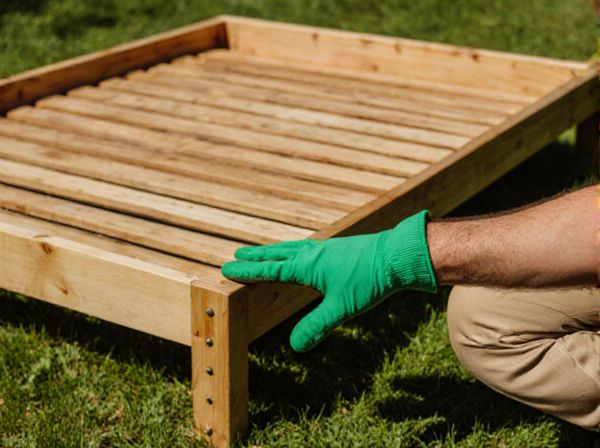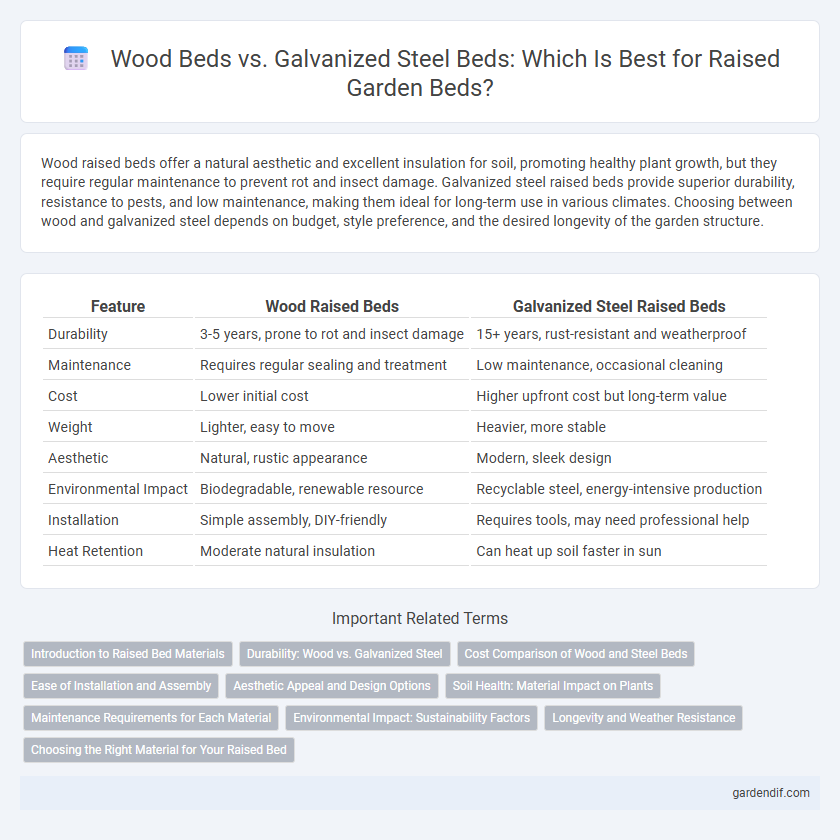
Wood beds vs galvanized steel beds Illustration
Wood raised beds offer a natural aesthetic and excellent insulation for soil, promoting healthy plant growth, but they require regular maintenance to prevent rot and insect damage. Galvanized steel raised beds provide superior durability, resistance to pests, and low maintenance, making them ideal for long-term use in various climates. Choosing between wood and galvanized steel depends on budget, style preference, and the desired longevity of the garden structure.
Table of Comparison
| Feature | Wood Raised Beds | Galvanized Steel Raised Beds |
|---|---|---|
| Durability | 3-5 years, prone to rot and insect damage | 15+ years, rust-resistant and weatherproof |
| Maintenance | Requires regular sealing and treatment | Low maintenance, occasional cleaning |
| Cost | Lower initial cost | Higher upfront cost but long-term value |
| Weight | Lighter, easy to move | Heavier, more stable |
| Aesthetic | Natural, rustic appearance | Modern, sleek design |
| Environmental Impact | Biodegradable, renewable resource | Recyclable steel, energy-intensive production |
| Installation | Simple assembly, DIY-friendly | Requires tools, may need professional help |
| Heat Retention | Moderate natural insulation | Can heat up soil faster in sun |
Introduction to Raised Bed Materials
Wood raised beds offer natural insulation, promoting soil warmth and fostering a healthy plant environment, while galvanized steel beds provide exceptional durability and resistance to pests and rot. Cedar and redwood are popular wood choices due to their natural resistance to decay, whereas galvanized steel beds feature a zinc coating that prevents rust and extends lifespan. Selecting the right material hinges on balancing aesthetics, longevity, maintenance, and environmental impact for optimal garden performance.
Durability: Wood vs. Galvanized Steel
Galvanized steel raised beds outperform wood in durability due to their resistance to rot, pests, and weathering, ensuring a longer lifespan without the need for frequent replacement. Wood beds, especially untreated varieties, are prone to decay, insect damage, and moisture-related deterioration, requiring regular maintenance and eventual replacement. Galvanized steel's corrosion-resistant coating provides a robust barrier against rust, making it a low-maintenance option ideal for long-term garden structures.
Cost Comparison of Wood and Steel Beds
Galvanized steel raised beds typically cost more upfront than wood beds due to material and manufacturing expenses but offer superior durability and longer lifespan, reducing replacement costs over time. Wood beds, particularly those made from cedar or redwood, provide a more affordable initial investment while offering natural aesthetics but may require more frequent maintenance and replacement due to rot and weathering. Factoring in lifespan and maintenance, galvanized steel beds present better long-term value despite higher initial costs, whereas wood beds appeal to budget-conscious gardeners prioritizing immediate affordability.
Ease of Installation and Assembly
Wood raised beds offer straightforward assembly with common tools and easily customizable sizes, making them ideal for DIY enthusiasts. Galvanized steel beds, while lightweight and durable, often feature pre-drilled holes and interlocking panels that simplify installation but may require additional hardware. Both materials provide quick setup options, yet wood beds generally allow more flexibility in design and modifications during assembly.
Aesthetic Appeal and Design Options
Wood raised beds offer a warm, natural aesthetic that blends seamlessly with garden landscapes, available in various stains and finishes to complement diverse styles. Galvanized steel beds provide a sleek, modern look with clean lines and a reflective surface that can enhance contemporary garden designs. Both materials allow for customizable shapes and sizes, but wood offers greater versatility in textures and colors, while steel emphasizes durability and minimalism.
Soil Health: Material Impact on Plants
Wooden raised beds naturally enhance soil health by providing better aeration and moisture retention, which nurtures beneficial microbes and plant roots. Galvanized steel beds resist decay and pests but may cause soil temperature fluctuations and zinc leaching, potentially affecting sensitive plants. Choosing wood supports organic soil ecosystems, while steel demands careful management to maintain optimal plant growth conditions.
Maintenance Requirements for Each Material
Wood raised beds require regular sealing or staining to protect against moisture, rot, and insect damage, typically needing maintenance every 1-3 years depending on exposure. Galvanized steel raised beds offer superior durability with minimal upkeep, as they resist rust and corrosion naturally, requiring only occasional cleaning to maintain appearance. Choosing galvanized steel reduces long-term maintenance efforts compared to wood, which demands more frequent attention to preserve structural integrity.
Environmental Impact: Sustainability Factors
Wooden raised beds, often made from sustainably sourced cedar or redwood, offer biodegradable and renewable options with lower embodied energy compared to galvanized steel. Galvanized steel beds, while highly durable and recyclable, require energy-intensive production processes that contribute to higher carbon footprints and resource depletion. Choosing wood from certified sustainable forests minimizes environmental impact, whereas steel beds provide longevity but with greater initial sustainability costs.
Longevity and Weather Resistance
Galvanized steel raised beds offer superior longevity and weather resistance compared to wood beds, as they are resistant to rust, rot, and insect damage, lasting up to 20 years with minimal maintenance. Wood beds, typically made from cedar or redwood, provide natural resistance to decay but generally last 5 to 10 years before requiring replacement or treatment. Steel beds withstand extreme weather conditions better, maintaining structural integrity in rain, snow, and UV exposure, while wooden beds may warp, crack, or degrade over time with consistent moisture and temperature fluctuations.
Choosing the Right Material for Your Raised Bed
Wood raised beds offer natural insulation benefits and an aesthetic appeal, with cedar and redwood being popular for their rot-resistant properties lasting up to 15 years. Galvanized steel beds provide superior durability and longevity, often exceeding 30 years, while resisting weather and pests without warping. Selecting the right material depends on climate, budget, and desired maintenance levels, with wood requiring more upkeep and steel offering a modern, low-maintenance solution.
Wood beds vs galvanized steel beds Infographic

 gardendif.com
gardendif.com